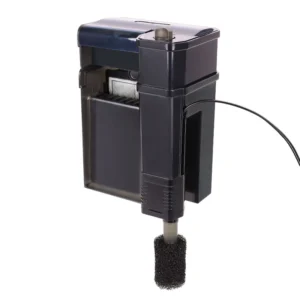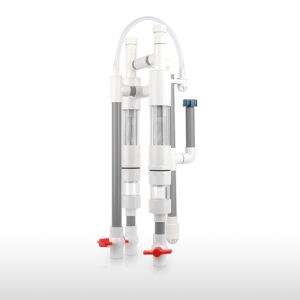Are there signs that your favorite aquarium fish is ill? Maybe it is spending more time camouflaging itself, or it is moving around with its fins either clinched or damaged. Some of them may be a hint to some other hidden illness or even pressure, i.e., why fish clamped fins.
Content Table
In this article, we won’t just talk about fish clamped fins, but we shall describe some of the causes of this vice among your fish. But knowing the source then it is easy to assist your fish to regain their proper health and strength.

Fish clamped fins
Illness, Stress, or Aquarium Problems
Aqua-tropical fishes, like any other pet,s may sometimes get sick, become stressed, or develop environmental complications. These problems can come out in many forms, and your fish is likely to see its general health deteriorate.
Common Illnesses
- Bacterial Infections: These diseases can manifest numerous clinical signs, from fin rot and skin ulcers to damage of internal organs.
- Fungal Infections: These infections are characterized by white or gray colored patches on part or the whole body of the fish as well as the fins.
- Parasite Infections: These minuscule parasites can scrape on, along, or in your fish’s skin, gills, or intestines, resulting in irritation, listlessness, and emaciation.
Stress Factors
- Poor Water Quality: This is because toxins such as ammonia, nitrite, or nitrate in the water can stress your fish and bring their immune levels low.
- Water Parameter Fluctuations: Environmental changes such as changes in water temperature, pH, or hardness may cause a form of stress on your fish.
- Overcrowding: Overpopulation in a tank is realized through overstressing and competitive consumption of resources.
- Incompatible Tank Mates: Some species are also assertive with other fish or become the property of their territory and may harass their tank mates.
- Poor Nutrition: Such a case can lead to stress on the basic functionality and digestive systems in your fish and, therefore, leave them vulnerable to diseases.
- Handling Stress: Harsh treatment or constant catching in the net will provoke your fish.
Aquarium Problems
- Filter Malfunction: Poor water quality and stress may be caused by a malfunctioning filter that is supposed to maintain water quality.
- Heater Malfunction: Temperature changes in water can affect your fish’s metabolism, and their immune systems will be compromised.
- Toxic Substances: Your fish may get exposed to toxic compounds, including cleansing chemicals, and orally take poisonous substances like drugs.

Discus fish clamped fins
How Are Your Aquarium Fish? Spotting the Signs of Trouble
A healthy freshwater fish is characterized by its active movements, bright coloration, and well-spread out fins. But stress, injury, or illness populate the fish, and its behavior and appearance show what is happening to this fish. Some other signs that may be noticed are as follows.
Behavioral Changes
- Lethargy: Reduced activity levels, spending more time resting on the bottom of the tank.
- Loss of Appetite: Refusing to eat or showing decreased interest in food.
- Erratic Swimming: Sudden, jerky movements or darting around the tank.
- Hiding: Retreating to dark corners or hiding behind decorations.
- Clamped Fins: Fins held close to the body, often a sign of stress or illness.
- Flaring Gills: Rapid breathing or gasping at the water’s surface.
Physical Changes
- Discoloration: Loss of color, fading, or unusual spots or patches.
- Fin Rot: Frayed, torn, or missing fins.
- White Spots: Small white spots on the skin or fins, often a sign of ich.
- Red Streaks or Sores: Open wounds or inflamed areas on the skin.
- Bulging Eyes: A Fish that has bulging eyes is a sign of internal fluid buildup or infection.
- Swollen Belly: This can indicate internal parasites or organ problems.
If you notice any of these signs, it’s important to take action quickly. Begin by assessing the water quality, checking for potential stressors, and observing the fish’s behavior closely.

Why are fish clamped fins
Why Aquarium Fish Clamped Its Fins
The term clamped fins in aquarium fish means a situation where the fins of the fish are close to the body of the fish as can be compared with the usual spread-out fins. It is an indicator of discomfort or disease. Here are some potential causes and related diseases.
- Stress: Frequently, stress is reported due to poor water conditions, overcrowded tanks, or changes in the environment, which results in the clamping of the fins.
- Infections:
- Bacterial Infections: These can cause signs such as fins clamped, less active, change in colour.
- Parasites: Bacterial infection by Ich or Velvet may lead to irritation and clamping of a deck as the fish pulls away.
- Swim Bladder Disease: Whenever a fish’s swim bladder is abnormal, clamped fins are accompanied by problems with swimming and buoyancy.
- Water Quality Issues: Stress is caused by factors such as high ammonia, nitrite, or low oxygen in water hence, the outcome is clamped fins in the fish.
- Physical Injury: Clamping may happen when either the fins of the fish are damaged, whether through injuries or any other means.
- Temperature Fluctuations: Water temperature should not fluctuate at any time because extreme changes cause stress to the fish and result in the clamping of the fins.
How to Treat Clamped Fins for Pet Fish
Curing clamped fins in pet fish can be a bit challenging because the condition can be caused by stress, infections, poor water quality, and maybe some other factors. Here’s a specific, step-by-step guide to treating why fish clamped fins.
Check and Improve Water Quality
- Test Water Parameters: This means that the quantity of ammonia should be 0, nitrites should be zero as well, and the nitrates should be below 20. Temperature and pH are required to be kept constant with the optimum conditions for the particular species of fish.
- Water Changes: Water exchange can be taught with a 20-30% water change to enhance water existence. If these levels are not as they should be, then make these changes slowly in order not to stress the fish any further.
- Filtration: Check if your filter is running smoothly and that the water is properly seasoned, in particular, if the oxygen is low.

Clownfish clips its fins
Treat for Infections or Parasites
- Medications: If the clamped fins are caused by a bacterial or parasitic illness (for example, Ich, Velvet) treat the fish accordingly. In the case of protozoa, copper-based treatments or formalin are used, depending on the severity, and antibiotics for bacterial diseases. It is very important to adhere to the recommended dosages of the drugs to be taken.
- Quarantine Sick Fish: In case other fish are healthy, the sick fish should be placed in a hospital or quarantine tank to avoid the spread of possible infections.
Address Stress Factors
- Reduce Stressors: If clamped fins are attributed to stress, then overcrowding, poor tank mates, or abrupt change in environment, remedies can be increased provision of hiding spaces, change of aggressive/competitive tank mates, and increase in tank space respectively.
- Environmental Enrichment: This is good for decreasing stress. You must install new plants, caves, and shelters where the fish can hide.
Monitor Temperature and Salinity
- Maintain Stable Temperature: Temperature change is particularly devastating to fish stress as well as their physical condition because it causes a shock. Also, check the free area temperature and ensure that the tank’s temperature is okay for your species, which should range between 75-80°F for tropical fish.
- Use Salt Treatment: For a particular species, raising the tank water with aquarium salt has the potential of helping to treat minor infections and reduce stress, as well as a tonic to the fish gills. Do not use it for catfish, tropical or scaleless fish, and other sizeable fish since they are sensitive to salt.
Ensure Proper Nutrition
Some fish may have clamped fins, which is an indication that the fish is malnourished or simply not getting adequate nutrition. Feed your fish well by offering good quality foods that are different from the normal and common pellet and flake foods, but the frozen or live ones. Promote the well-being of the immune system through food products that contain vitamins and minerals.
Observe and Adjust
- Monitor Progress: Following that, they discuss the possible reasons and then guard and monitor the fish every day. If the clamped fins do not resolve, then consult the water quality or examine an alternate treatment for the infection.
- Gradual Adjustments: It is advisable not to act on them because any changes in water conditions or the environment will make it worse. Always make changes progressively and give the organisms stable conditions.

betta fish clamped fins
Why Betta Fish Clamped Fins
Betta Fish Clamped Fins: A Common Concern
Betta fish are known for their vibrant colors and flowing fins. However, when a betta’s fins become clamped, it’s a clear sign of distress. Clamped fins can be caused by various factors, including poor water quality, stress, or illness.
Here’s how to address this issue
- Assess Water Quality
- Test Water Parameters: Use a reliable water testing kit to measure pH, ammonia, nitrite, and nitrate levels.
- Water Changes: Perform regular water changes to maintain optimal water quality.
- Filter Maintenance: Clean the filter regularly to ensure proper filtration.
- Reduce Stress
- Tank Mates: Ensure your betta fish is housed alone or with compatible tank mates.
- Tank Environment: Provide a peaceful environment with plenty of hiding spots and live plants.
- Minimize Handling: Handle your betta fish gently and only when necessary.
- Treat Potential Infections
- Observe for Signs of Illness: Look for signs of fungal or bacterial infections, such as white spots or red sores.
- Consult a Veterinarian: If you suspect an infection, consult a fish veterinarian for proper diagnosis and treatment.
- Medication: If necessary, use appropriate medications as prescribed by a veterinarian.
- Improve Diet
- High-Quality Food: Feed your betta fish a high-quality diet, such as live or frozen food, to boost their immune system.
- Regular Feeding: Feed your betta fish small amounts of food multiple times a day.
Looking Ahead
Learning about some of the causes of fish clamped fins and how they should be treated will assist in helping your aquatic fish from the aquarium to be relieved. Angular cheilitis is best treated in the earliest stage, and initiating the best treatment plan as soon as possible is equally important. If you doubt the cause or handling of the disease, get a professional fish doctor to advise you. A healthy and happy aquarium is always a good sign for you and your fish.



Leave a comment